2001 BMW 540I SEDAN window
[x] Cancel search: windowPage 174 of 238

174nCaring for your car
Window care
You can use window and glass cleaner
to clean inside window surfaces and
mirrors without smearing and streaking.
Never use polishing pastes or abrasive
(quartz) cleansers on mirror lenses.
When caring for break-resistant
security glass
*, observe the fol-
lowing instructions:
The inner surface of the side windows
is coated with a plastic film. For this
reason, do not affix any decals or adhe-
sive stickers on the inside of these win-
dows unless they are to be placed there
permanently.
Wash the glass with clean water. If nec-
essary, you may add a commercially-
available mild household cleaner. Do
not use abrasive cleaners.
If the windows are fogged or iced over,
treat them with an anti-misting cloth or
a deicer spray – do not use an ice
scraper. <
Clean the wiper blades with soapy wa-
ter. The wiper blades should be re-
placed twice a year, before and after
the cold season.
Use only wiper blades which have
been approved by BMW. <
Caring for other vehicle
components and materials
Light-alloy wheels should be treated
with alloy wheel cleaner, especially
during the winter months. However, do
not use aggressive products contain-
ing acids, strong alkalis or abrasives.
Do not use steam cleaners operating at
temperatures above 140 7 (60 6).
(Follow the manufacturer's instruc-
tions.)
If your vehicle has chrome parts
* such
as window moldings, door handles or
other items, clean these parts carefully
with ample clean water, especially if
they have an accumulation of road salt.
Use a chrome polish for an additional
treatment.
Plastic components, vinyl upholstery,
headliners, lamp lenses, the clear cover
of the instrument cluster and compo-
nents with a sprayed dull black surface
can be cleaned with water (add plastic
cleaner as required). Do not allow mois-
ture to soak through the seats or head-
liner. Never use solvents such as lac-
quer thinner, heavy-duty grease
remover, fuels, etc. Rubber components should be cleaned
with water only; a rubber treatment or
silicone spray may also be applied.
The safety belts should be cleaned with
a mild soap and water solution without
being removed from the vehicle. Never
attempt chemical or dry cleaning, as
damage to the belt fabric could result.
After cleaning, never allow the inertia
reel to retract the belts until they are
completely dry. Dirty safety belts pre-
vent the inertia reel mechanism from
retracting the strap properly, and thus
constitute a safety hazard.
Heavily soiled floor carpets and mats
*
can be cleaned with an interior cleaner.
The floor mats can be removed from
the vehicle for cleaning.
Please use only a damp cloth to clean
wooden fascia panels and components.
Follow up by drying with a soft cloth.
Use cleaning and car-care
products that you can obtain
at your BMW center. <
Page 175 of 238
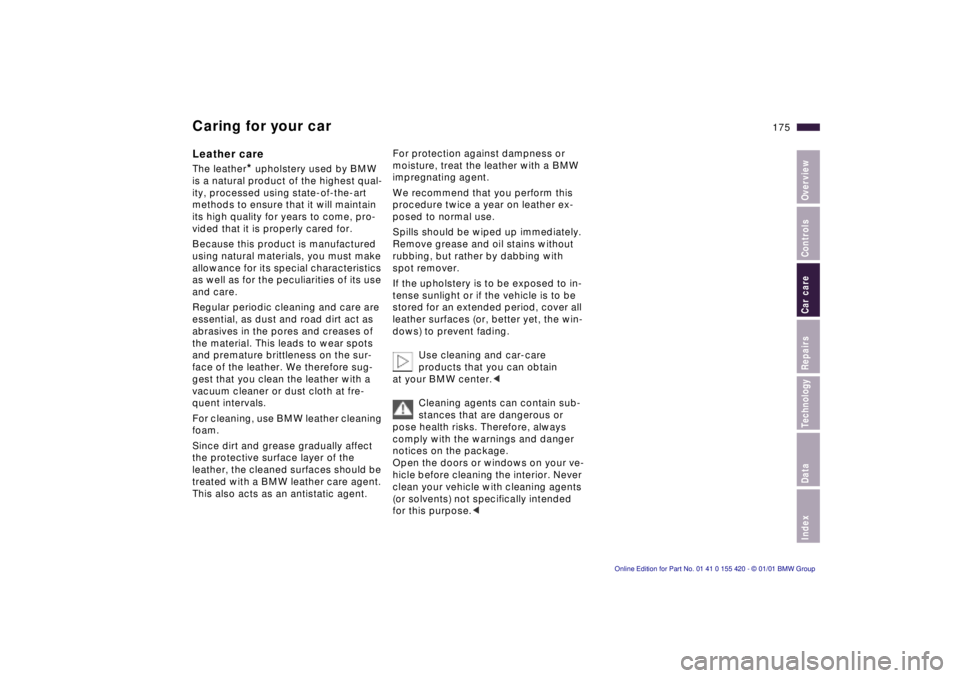
Index
Data
Technology
Repairs
Car care
Controls
Overview
175nCaring for your car
Leather care
The leather* upholstery used by BMW
is a natural product of the highest qual-
ity, processed using state-of-the-art
methods to ensure that it will maintain
its high quality for years to come, pro-
vided that it is properly cared for.
Because this product is manufactured
using natural materials, you must make
allowance for its special characteristics
as well as for the peculiarities of its use
and care.
Regular periodic cleaning and care are
essential, as dust and road dirt act as
abrasives in the pores and creases of
the material. This leads to wear spots
and premature brittleness on the sur-
face of the leather. We therefore sug-
gest that you clean the leather with a
vacuum cleaner or dust cloth at fre-
quent intervals.
For cleaning, use BMW leather cleaning
foam.
Since dirt and grease gradually affect
the protective surface layer of the
leather, the cleaned surfaces should be
treated with a BMW leather care agent.
This also acts as an antistatic agent. For protection against dampness or
moisture, treat the leather with a BMW
impregnating agent.
We recommend that you perform this
procedure twice a year on leather ex-
posed to normal use.
Spills should be wiped up immediately.
Remove grease and oil stains without
rubbing, but rather by dabbing with
spot remover.
If the upholstery is to be exposed to in-
tense sunlight or if the vehicle is to be
stored for an extended period, cover all
leather surfaces (or, better yet, the win-
dows) to prevent fading.
Use cleaning and car-care
products that you can obtain
at your BMW center. <
Cleaning agents can contain sub-
stances that are dangerous or
pose health risks. Therefore, always
comply with the warnings and danger
notices on the package.
Open the doors or windows on your ve-
hicle before cleaning the interior. Never
clean your vehicle with cleaning agents
(or solvents) not specifically intended
for this purpose. <
Page 182 of 238
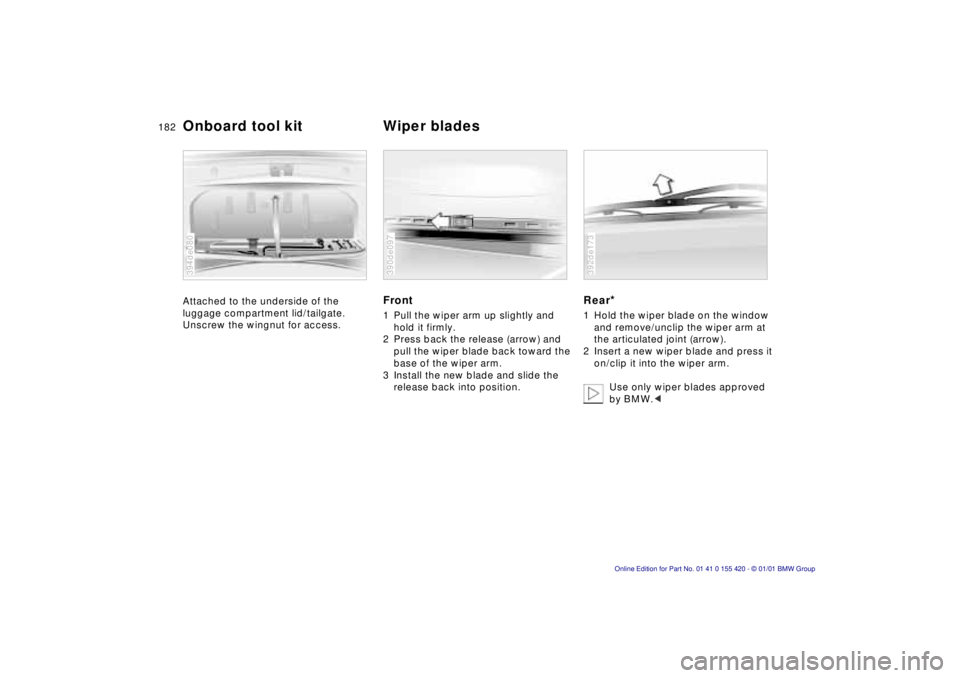
182n
Attached to the underside of the
luggage compartment lid/tailgate.
Unscrew the wingnut for access.
394de080
Front
1 Pull the wiper arm up slightly and hold it firmly.
2 Press back the release (arrow) and pull the wiper blade back toward the
base of the wiper arm.
3 Install the new blade and slide the release back into position.
390de097
Rear*
1 Hold the wiper blade on the window and remove/unclip the wiper arm at
the articulated joint (arrow).
2 Insert a new wiper blade and press it on/clip it into the wiper arm.
Use only wiper blades approved
by BMW. <
392de173
Onboard tool kit Wiper blades
Page 201 of 238
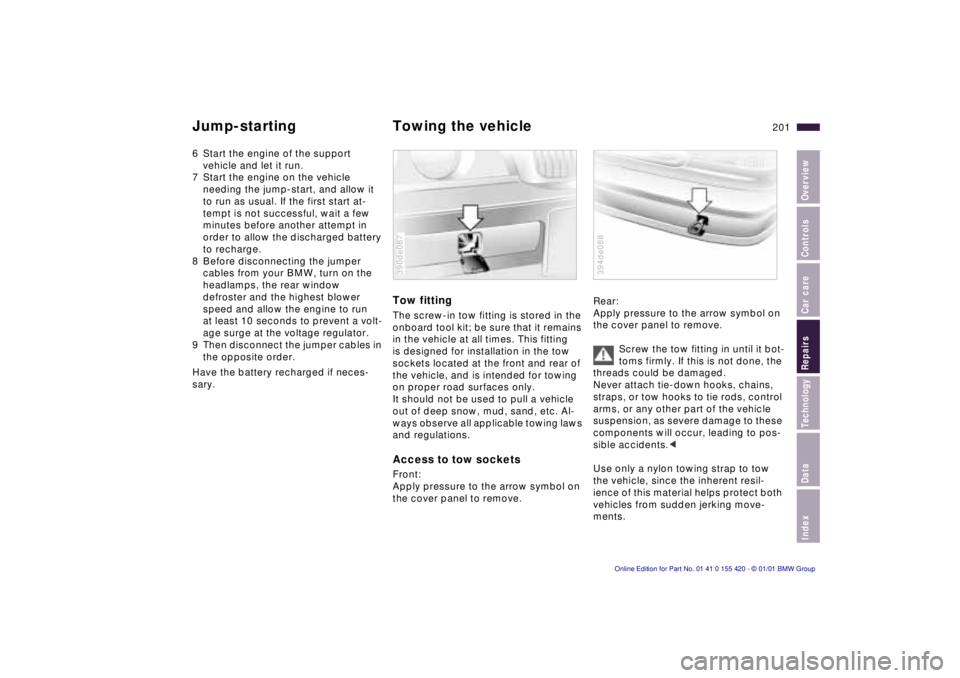
Index
Data
Technology
Repairs
Car care
Controls
Overview
201nJump-starting Towing the vehicle
6 Start the engine of the support
vehicle and let it run.
7 Start the engine on the vehicle needing the jump-start, and allow it
to run as usual. If the first start at-
tempt is not successful, wait a few
minutes before another attempt in
order to allow the discharged battery
to recharge.
8 Before disconnecting the jumper cables from your BMW, turn on the
headlamps, the rear window
defroster and the highest blower
speed and allow the engine to run
at least 10 seconds to prevent a volt-
age surge at the voltage regulator.
9 Then disconnect the jumper cables in the opposite order.
Have the battery recharged if neces-
sary.
Tow fitting
The screw-in tow fitting is stored in the
onboard tool kit; be sure that it remains
in the vehicle at all times. This fitting
is designed for installation in the tow
sockets located at the front and rear of
the vehicle, and is intended for towing
on proper road surfaces only.
It should not be used to pull a vehicle
out of deep snow, mud, sand, etc. Al-
ways observe all applicable towing laws
and regulations.
Access to tow sockets
Front:
Apply pressure to the arrow symbol on
the cover panel to remove.
390de087
Rear:
Apply pressure to the arrow symbol on
the cover panel to remove.
Screw the tow fitting in until it bot-
toms firmly. If this is not done, the
threads could be damaged.
Never attach tie-down hooks, chains,
straps, or tow hooks to tie rods, control
arms, or any other part of the vehicle
suspension, as severe damage to these
components will occur, leading to pos-
sible accidents. <
Use only a nylon towing strap to tow
the vehicle, since the inherent resil-
ience of this material helps protect both
vehicles from sudden jerking move-
ments.
394de088
Page 202 of 238
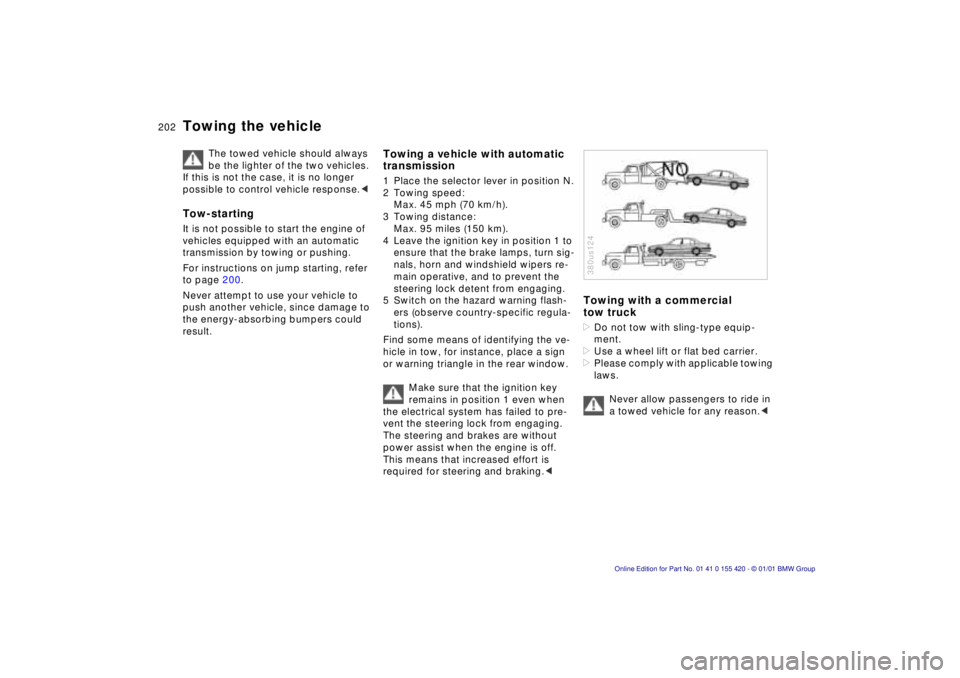
202nTowing the vehicle
The towed vehicle should always
be the lighter of the two vehicles.
If this is not the case, it is no longer
possible to control vehicle response. <
Tow-starting
It is not possible to start the engine of
vehicles equipped with an automatic
transmission by towing or pushing.
For instructions on jump starting, refer
to page 200.
Never attempt to use your vehicle to
push another vehicle, since damage to
the energy-absorbing bumpers could
result.
Towing a vehicle with automatic
transmission
1 Place the selector lever in position N.
2 Towing speed: Max. 45 mph (70 km/h).
3 Towing distance: Max. 95 miles (150 km).
4 Leave the ignition key in position 1 to ensure that the brake lamps, turn sig-
nals, horn and windshield wipers re-
main operative, and to prevent the
steering lock detent from engaging.
5 Switch on the hazard warning flash- ers (observe country-specific regula-
tions).
Find some means of identifying the ve-
hicle in tow, for instance, place a sign
or warning triangle in the rear window.
Make sure that the ignition key
remains in position 1 even when
the electrical system has failed to pre-
vent the steering lock from engaging.
The steering and brakes are without
power assist when the engine is off.
This means that increased effort is
required for steering and braking. <
Towing with a commercial
tow truck
> Do not tow with sling-type equip-
ment.
> Use a wheel lift or flat bed carrier.
> Please comply with applicable towing
laws.
Never allow passengers to ride in
a towed vehicle for any reason. <
380us124
Page 209 of 238
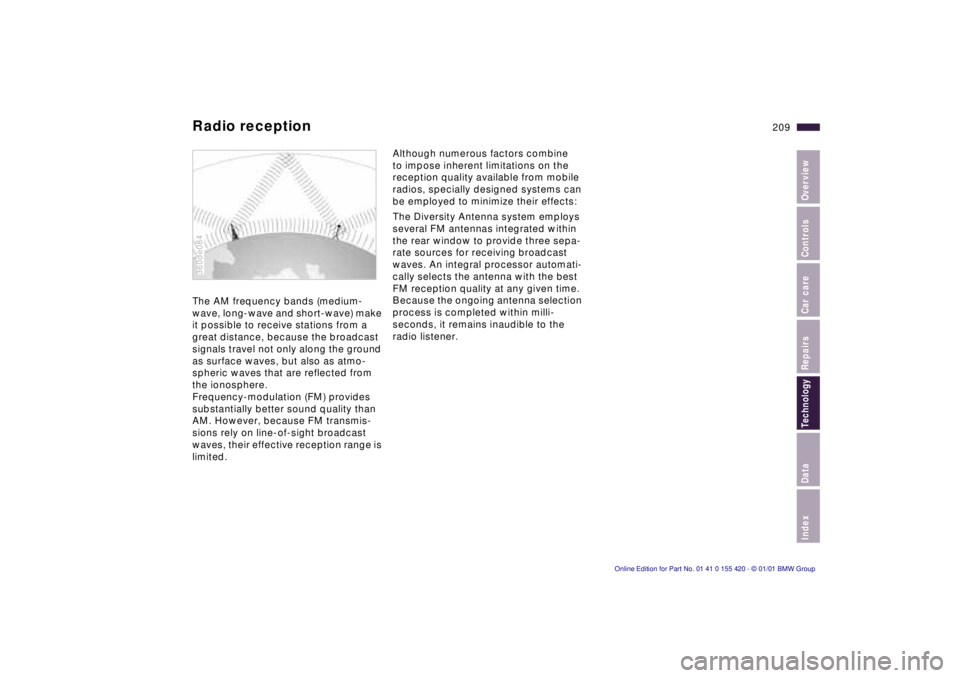
Index
Data
Technology
Repairs
Car care
Controls
Overview
209nRadio reception
The AM frequency bands (medium-
wave, long-wave and short-wave) make
it possible to receive stations from a
great distance, because the broadcast
signals travel not only along the ground
as surface waves, but also as atmo-
spheric waves that are reflected from
the ionosphere.
Frequency-modulation (FM) provides
substantially better sound quality than
AM. However, because FM transmis-
sions rely on line-of-sight broadcast
waves, their effective reception range is
limited.
360de084
Although numerous factors combine
to impose inherent limitations on the
reception quality available from mobile
radios, specially designed systems can
be employed to minimize their effects:
The Diversity Antenna system employs
several FM antennas integrated within
the rear window to provide three sepa-
rate sources for receiving broadcast
waves. An integral processor automati-
cally selects the antenna with the best
FM reception quality at any given time.
Because the ongoing antenna selection
process is completed within milli-
seconds, it remains inaudible to the
radio listener.
Page 212 of 238
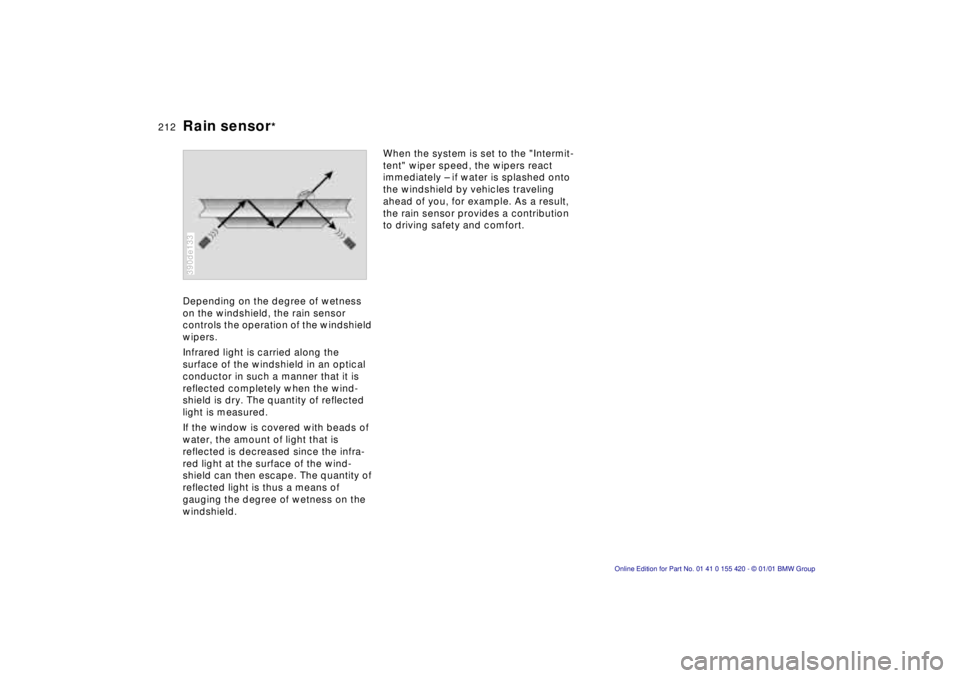
212nRain sensor*
Depending on the degree of wetness
on the windshield, the rain sensor
controls the operation of the windshield
wipers.
Infrared light is carried along the
surface of the windshield in an optical
conductor in such a manner that it is
reflected completely when the wind-
shield is dry. The quantity of reflected
light is measured.
If the window is covered with beads of
water, the amount of light that is
reflected is decreased since the infra-
red light at the surface of the wind-
shield can then escape. The quantity of
reflected light is thus a means of
gauging the degree of wetness on the
windshield.
390de133
When the system is set to the "Intermit-
tent" wiper speed, the wipers react
immediately – if water is splashed onto
the windshield by vehicles traveling
ahead of you, for example. As a result,
the rain sensor provides a contribution
to driving safety and comfort.
Page 228 of 238

Everything from A to Z
A
ABS (Antilock Brake
System)23, 143
Accessories6
Activated-charcoal
filter119
Active seat55, 210
Adaptive Transmission
Control (ATC)72, 207
Add
antifreeze168
t
brake fluid168
t
engine coolant168
t
engine oil165
t
washer fluids164
t
Adjust washer
nozzles164
t
Adjusting
backrest angle53
backrest, forward/
backward52
seats52
steering wheel56
temperature110, 116
thigh support55
Air conditioner108
Air distribution110, 116
Air outlets108, 114
Air pressure29
t
, 150
t
Air supply110, 117
Air vent108, 114Airbags23, 62, 176, 206
Alarm system47
Antennas149
Antifreeze167
t
radiator146
Antilock Brake System
(ABS)23, 143
Anti-theft alarm system47
Anti-theft protection39
Approved axle weight221
Approved gross vehicle
weight221
Approved roof load
capacity221
Aquaplaning141, 150
Arrival time97
ASC+T/DSC (Automatic
Stability Control plus
Traction/Dynamic Stability
Control)24, 102, 208
Ashtray126
ATC (Adaptive Transmission
Control)72, 207
Attach vacuum cleaner127
AUC (Automatic
recirculated-air
control)117
Automatic car washes171
Automatic climate
control114
remove condensation from
windows117Automatic cruise control81
Automatic curb monitor59
Automatic dimming
interior rearview mirror57
Automatic rear window
cleaning80
Automatic recirculated-air
control (AUC)117
Automatic Stability Control
plus Traction/Dynamic
Stability Control (ASC+T/
DSC)24, 102, 208
Automatic transmission72
Automatic transmission with
Steptronic75
Average fuel
consumption89
Average speed89, 98
Avoid false alarms48
t
Axle loads221
B
Backrest, adjusting52, 55
Backup lamps71
bulb replacement186
t
Battery193
t
, 224
capacity224
charge condition194
t
charging194
discharged200
t
removing and
installing195
t
Belts61
Beverage holder125
Blower110, 117
BMW active seat55, 210
BMW comfort seat54
BMW sports seat55
BMW Universal
Transmitter121
Body-cavity protectant172
Brake faults146
t
Brake hydraulic
system22, 146
Brake lamps, bulb
replacement186
t
Brake system140
brake faults146
brake fluid168
brake lamps, bulb
replacement186
brake pads23
disc brakes144
parking brake23, 70
Brake-in procedure140
Break-resistant security
glass174
care174
t
Bulb replacement183
t
C
California Proposition
65 Warning177
Capacity223